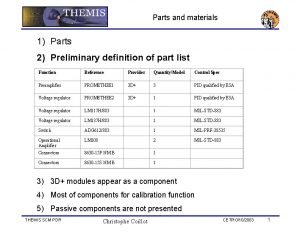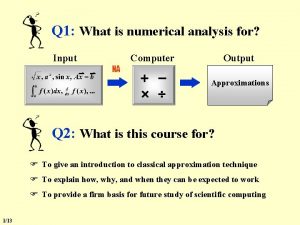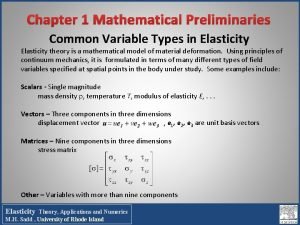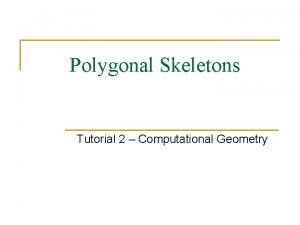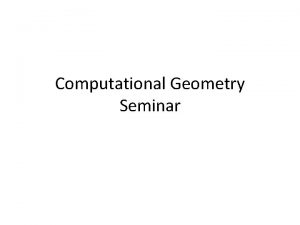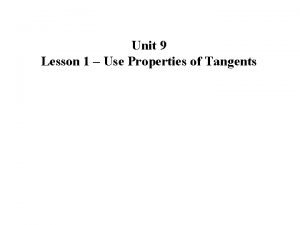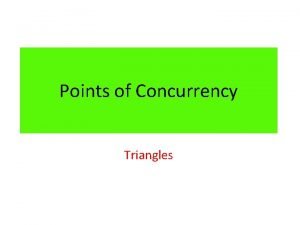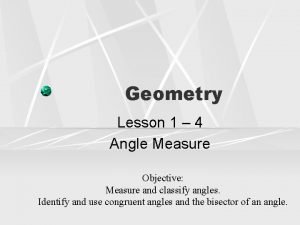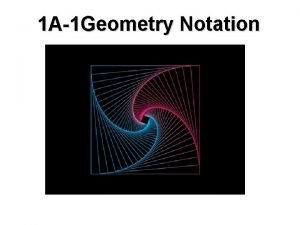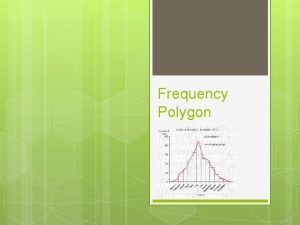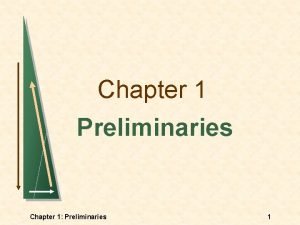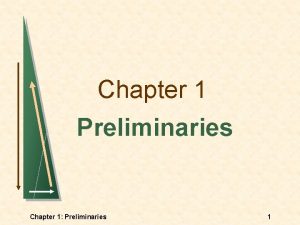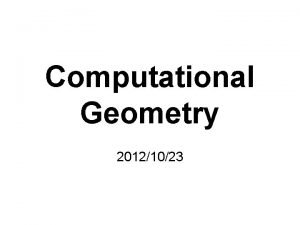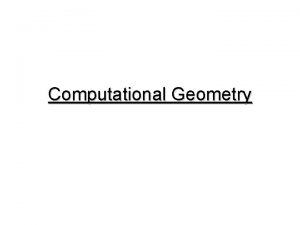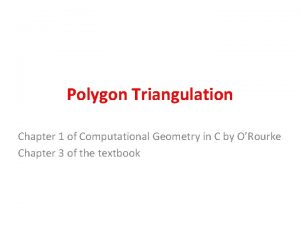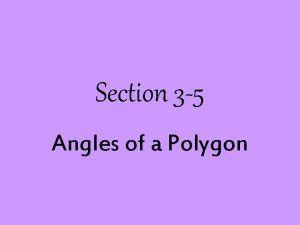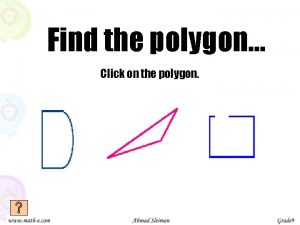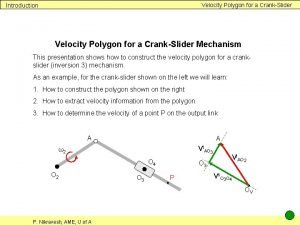Computational Geometry TOPICS Preliminaries Point in a Polygon




















- Slides: 20

Computational Geometry TOPICS Preliminaries Point in a Polygon Construction Convex Hulls q q CSE 5311 Kumar 1

Geometric Algorithms find applications in such areas as • Computer Graphics • Computer Aided Design • VLSI Design • GIS • Robotics algorithms dealing with points, line segments, and polygons In particular, the algorithms will • Determine whether a point is inside a Polygon • Construct a Polygon CSE 5311 Hulls Kumar 2 • Determine Convex

Preliminaries: A point p is represented as a pair of coordinates (x, y) A line is represented by a pair of points A path is a sequence of points p 1, p 2, . . . pn and the line segments connecting them, p 1 -p 2, p 2 -p 3, . . . , p k-1 -pk. A closed path whose last point is the same as the first is a polygon. A simple polygon is one whose corresponding path does not intersect itself. It encloses a region in the plane. A Convex Polygon is a polygon such that any line segment connecting two points inside the polygon is itself entirely in the polygon. The convex hull of a set of points is defined as the smallest convex polygon enclosing all the given points. CSE 5311 Kumar 3

q(x 2, y 2) p(x 1, y 1) r(x 3, y 3) s(x 4, y 4) This is not a convex polygon A line segment connecting two points: The points are inside the polygon The line segment is not entirely in the polygon CSE 5311 Kumar 4

Determining whether a point is inside a polygon Given a simple polygon P, and a point q, determine whether the point is inside or outside the polygon. (a non-convex polygon) CSE 5311 Kumar 5

Procedure Point_in_a_Polygon(P, q) Input : P ( a simple polygon with vertices p 1, p 2, p 3, and edges e 1, e 2, e 3, … en and q (x 0, y 0) a point. Output: INSIDE ( a Boolean variable, True if q is inside P, and false otherwise) Count 0; for all edges ei of the polygon do if the line x = x 0 intersects ei then yi y coordinate of the intersection between lines ei and x=x 0; if yi > y 0 then Count +1; if count is odd then INSIDE TRUE; else INSIDE FALSE This does not work if the line passes through terminal points CSE 5311 Kumar 6 of edges

It takes constant time to perform an intersection between two line segments. The algorithm computes n such intersections, where n is the size on the polygon. Total running time of the algorithm, O(n). CSE 5311 Kumar 7

Constructing a Simple Polygon Given a set of points in the plane, connect them in a simple closed path. Consider a large circle that contains all the points. Scan the area of C by a rotating line. Connect the points in the order they are encountered in the scan. CSE 5311 Kumar 8

Procedure Simple_Polygon Input : p 1, p 2, . . . pn (points in the polygon) Output : P ( a simple polygon whose vertices p 1, p 2, . . . pn are in some order), 1. for i 2 to n 2. i angle between line p 1 -pi and the x-axis; 3. sort the points according to the angles (use the corresponding priority for the point and do a heapsort) 4. P is the polygon defined by the list of points in the sorted order. Complexity : Complexity of the sorting algorithm. CSE 5311 Kumar 9

Convex Hulls The convex hull of a set of points is defined as the smallest convex polygon enclosing all the points in the set. The convex hull is the smallest region encompassing a set of points. A convex hull can contain as little as three and as many as all the points as vertices. Problem Statement : Compute the convex hull of n given points in the plane. There are two algorithms Gift Wrapping O(n 2) Graham's Scan O(nlogn) CSE 5311 Kumar 10

p 6 p 2 L p 1 p 5 p 3 p 4 CSE 5311 Kumar 11

Procedure Gift_Wrapping(p 1, p 2, . . . pn) Input : p 1, p 2, . . . pn ( a set of points in the plane) Output : P (the convex hull of p 1, p 2, . . . pn ) 1. P {0} or ; 2. p a point in the set with the largest x-coordinate; 3. Add p to P; 4. L line containing p and parallel to the x-axis; 5. while P < n do 6. q point such that the angle between the line -p-qand L is minimal among all points; 7. add q to P; 8. L line -p-q-; 9. p q; CSE 5311 Kumar 12

Graham's Scan: Given a set of n points in the plane, ordered as in the algorithm Simple Polygon, we can find a convex path among the first k points whose corresponding convex polygon encloses the first k points. pk+1 qm-1 qm p 1 CSE 5311 Kumar 13

p 6 p 3 q 1: p 1 p 2 q 2: p 2 p 4 p 7 q 3: p 3 p 5 m: 3 p 1 p 6 p 8 q 3 q 2 p 4 -q 2 -q 3 - and -q 3 -p 4 - p 7 p 5 The angle is < 180 -q (m-1)-qm- and -q m-pk - q 1 180 o CSE 5311 Kumar p 8 k =4 14

-q 3 -q 4 - and -q 4 -p 5 p 6 k =5 qm: p 4 q 3 m: 4 q 4 p 7 q 2 p 5 p 6 q 3 q 1 q 2 q 4 p 8 p 7 q 5 qm: p 5 k=6 q 1 m: 5 p 8 CSE 5311 Kumar 15

p 6 k=6 q 3 q 2 q 4 p 7 Angle between -q 4 -q 5 - and -q 5 -p 6 - is greater than 180 Therefore m = m-1 = 4 q 5 We skip p 5 p 6 q 1 q 3 p 8 q 2 q 4 Angle between -q 3 -q 4 - and p 7 -q 4 -p 6 - is greater than 180 q 1 Therefore m = m-1 = 3 p 8 We skip p 4 -q 3 -q 4 - and -q 4 -p 6 CSE 5311 Kumar 16 k=6

p 6 k=6 q 3 q 2 p 7 q 1 p 8 Angle between -q 2 -q 3 - and -q 3 -p 6 - is less than 180 Therefore m = m+1 = 4 and q 4 = p 6 CSE 5311 Kumar 17

k=7 q 4 q 3 q 2 k=8 p 7 q 1 q 4 q 3 q 2 p 8 q 5 q 1 p 8 CSE 5311 Kumar 18

q 4 q 3 q 2 q 5 q 1 q 6 CSE 5311 Kumar 19

Procedure Graham's Scan(p 1, p 2, . . . pn) Input : p 1, p 2, . . . pn(a set of points in the plane) Output : q 1, q 2, . . . qn( the convex hull of p 1, p 2, . . . pn) p 1 the point in the set with the largest x-coordinate (and smallest y-coordinate if there are more than one point with the same x-coordinate) Construct Simple Polygon and arrange points in order Let order be p 1, p 2, . . . pn q 1 p 1 ; q 2 p 2 ; q 3 p 3 ; (initially P consists of p 1, p 2, and p 3) m 3; for k 4 to n do while the angle between lines -q m-1 -qm- and -q m-pk - 180 o do m m-1; [Internal to the polygon] m m+1; qm p k ; CSE 5311 Kumar 20
 Apa itu preliminaries
Apa itu preliminaries Parts of preliminaries
Parts of preliminaries Halaman preliminaries
Halaman preliminaries Mathematical preliminaries in numerical computing
Mathematical preliminaries in numerical computing Chapter 1 mathematical preliminaries
Chapter 1 mathematical preliminaries Tied synoynm
Tied synoynm Straight skeleton
Straight skeleton Computational geometry
Computational geometry Not polygon
Not polygon Chapter 9 topics in analytic geometry
Chapter 9 topics in analytic geometry Lewis structure of pf3
Lewis structure of pf3 Electron domain geometry vs molecular geometry
Electron domain geometry vs molecular geometry Covalent bond order
Covalent bond order Point of tangency definition geometry
Point of tangency definition geometry Point-slope form definition geometry
Point-slope form definition geometry Name the point of concurrency of the angle bisectors
Name the point of concurrency of the angle bisectors Angle
Angle Geometric term modeled by each object
Geometric term modeled by each object An exact position
An exact position Characteristics of computational thinking
Characteristics of computational thinking Computational thinking algorithms and programming
Computational thinking algorithms and programming

